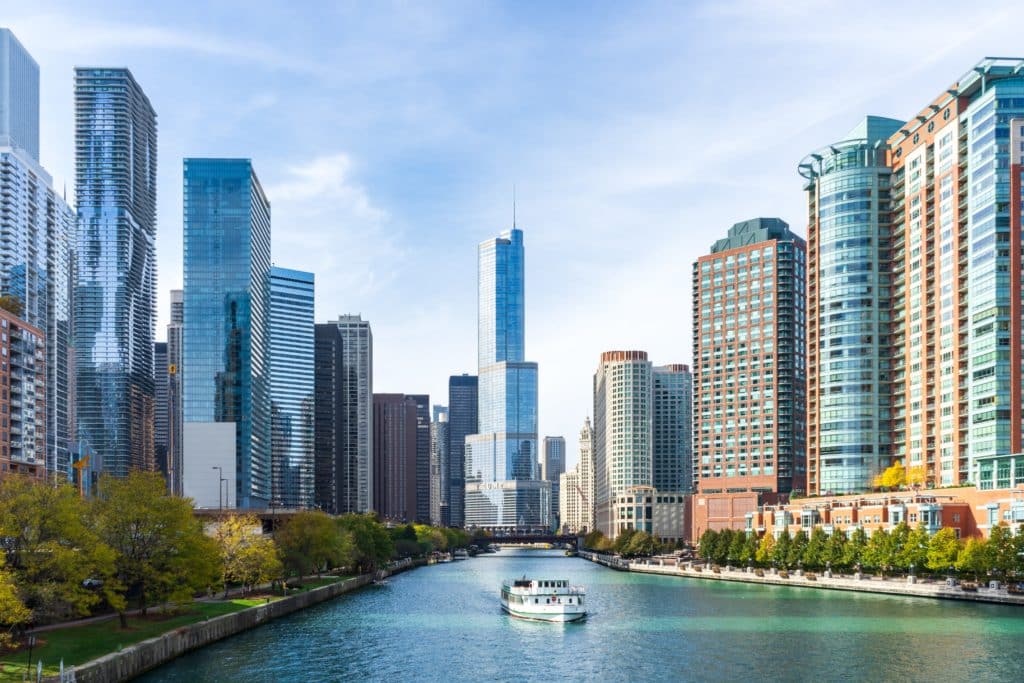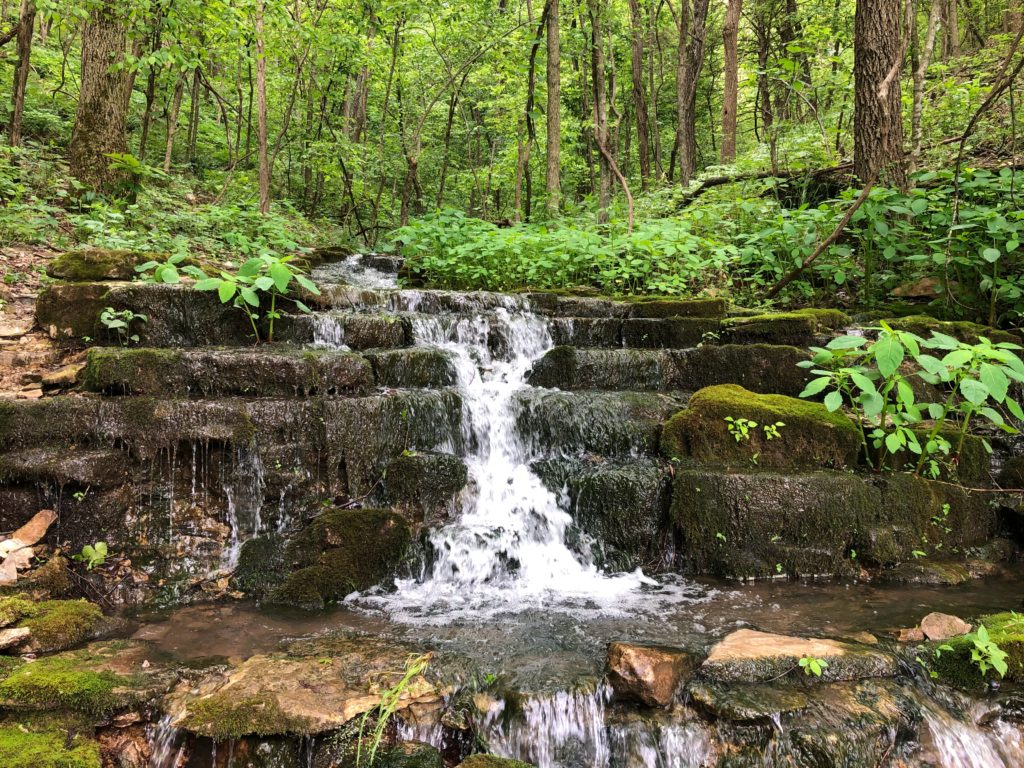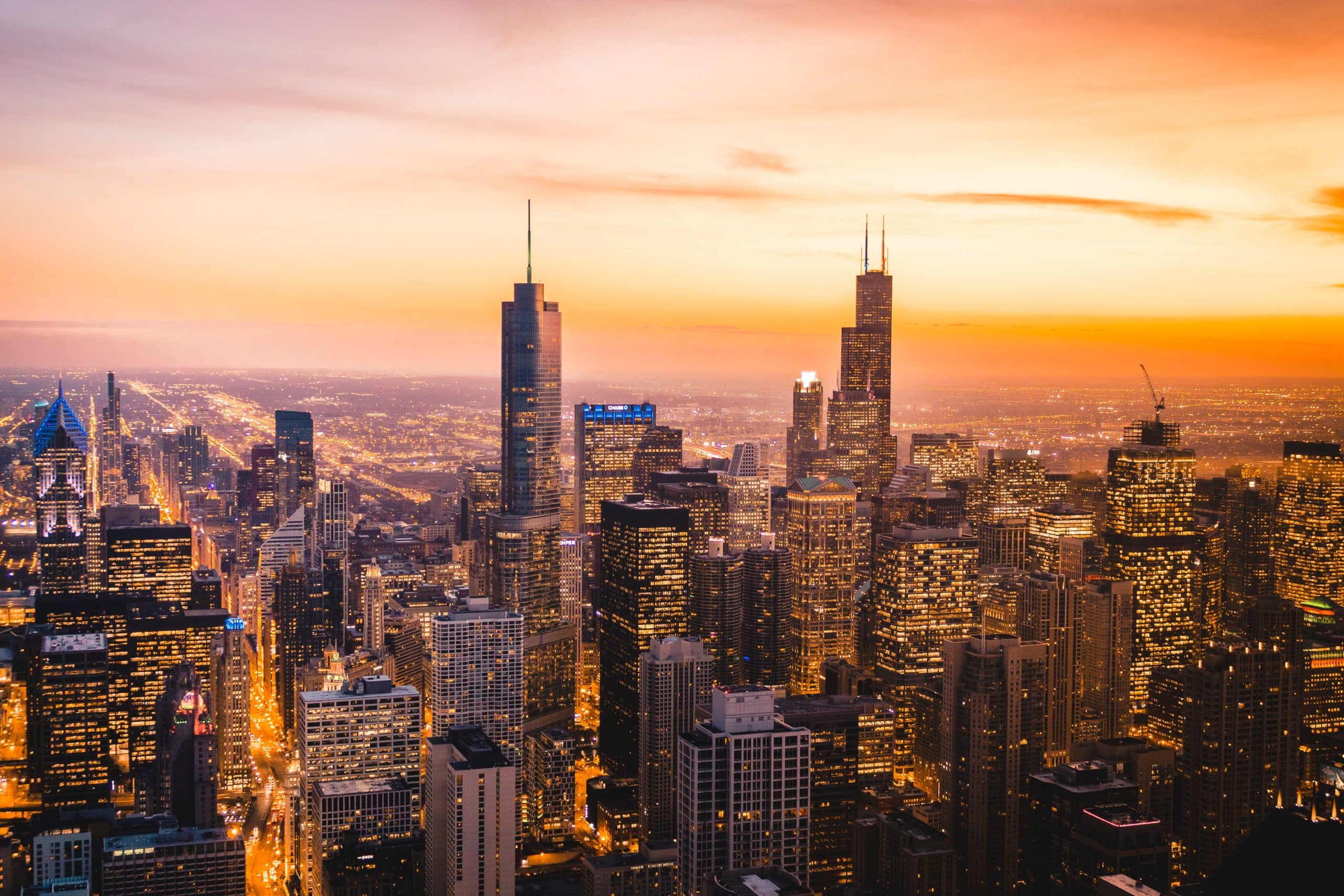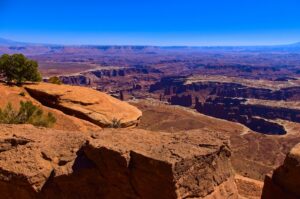 Chicago is a great city with plenty to do, but sometimes you just need to get out of town and explore nature. Luckily, there are plenty of beautiful national parks and forests close by that are perfect for weekend trips. These are all spots within six hours of Chicago. Here are ten of our favorites.
Chicago is a great city with plenty to do, but sometimes you just need to get out of town and explore nature. Luckily, there are plenty of beautiful national parks and forests close by that are perfect for weekend trips. These are all spots within six hours of Chicago. Here are ten of our favorites.
National Parks
Indiana Dunes National Park
1 Hour Southeast of Chicago
One of the newest national parks, Indiana Dunes National Park hugs 15 miles of the southern shoreline of Lake Michigan. Originally a national monument, the park was established in 2019. Known for its hiking and birding and, of course, the lake, you’ll find glacial dunes as high as 250 feet. In addition to the dunes, you’ll find prairies, wetlands, and forests. The park is rare for the diversity of ecosystems you’ll find in the small area.
In addition to the natural wonders, there are 50 miles of trails to hike and 37 miles of biking trails. The adjacent state park provides even more opportunities for recreation. And for those visiting in the winter, many of the trails also serve as great places to cross-country ski and snowshoe.
Perhaps no other national park is better for watching birds and fowl, whether they’re residents of the park or stopping by during their migration south. Especially in the fall, when the migration south begins, the Dunes is a gathering spot for hawks, herons, egrets, and other waterfowl. In May, the Indiana Audubon Society has their annual Indiana Dunes birding festival, where you can learn more about the birds and migrations from speakers and experts.
You can also camp in the park. The larger of the two campgrounds is Dunewood Campground, which has spots for both tents and RVs.
As of March 31, 2022, there is now an admission fee to Indiana Dunes National Park. It is $25 per vehicle or $15 for those entering on foot, bike or boat.
Cuyahoga Valley National Park
5 Hours and 30 Minutes East of Chicago
If you’re looking for a scenic and adventurous getaway, look no further than Cuyahoga Valley National Park. This beautiful park is located in northeastern Ohio and offers visitors a chance to experience nature at its finest. There are numerous hiking trails to explore, as well as plenty of opportunities to see wildlife. Plus, the park is also home to a number of historic sites and museums.
You can start your adventure at Brandywine Falls. This stunning waterfall is one of the most popular attractions in the park. After marveling at the falls, take a hike on the Ledges Trail. This moderate trail offers breathtaking views of the valley below. Be sure to bring your camera! In the evening, head to Beaver Marsh to try and spot some of the park’s resident beavers. You’ll also likely see the park’s many Great Blue Herons.
Don’t forget to spend some time exploring Horseshoe Pond. This serene spot is perfect for wildlife watching or simply enjoying a picnic lunch. In the afternoon, take a hike on the Towpath Trail. This easy trail follows an old canal towpath and takes you past many of the park’s historic sites. It runs through the length of the park and is great for walking, running, or biking.
To learn about the history of the area, don’t forget to visit park’s Canal Exploration Center. It gives a comprehensive overview of the history of the Ohio Canal, the remains of which run through the park. There’s also a working lock so you can learn about how boats used to move through the canal in the 19th century.
There is no admission fee for Cuyahoga Valley National Park.
Gateway Arch National Park
4 Hours and 30 Minutes South of Chicago
Gateway Arch National Park is unique among the nation’s national parks. First off, it’s the smallest. Less than one square mile, the home is located in downtown St. Louis. It’s the home to the Gateway Arch, standing at 630 feet and towering over the Mississippi River. The “Gateway to the West” was completed in 1965 and is the city’s most recognizable landmark.
The park, formerly the Jefferson National Expansion Memorial, was established as a national park in 2018. In addition to the Arch, the famous Old Courthouse is located within the park. The park provides a rich history of Thomas Jefferson, indigenous people and settlers who lived in the area, and some of the important civil rights cases of the 19th century. It is easily accessible and, with just a little planning, can be experienced in a single day.
The most recognizable feature of the park, and the symbol of St. Louis, is the famous Gateway Arch. The world’s tallest arch, it was opened to the public in 1965 after a year and a half of construction. You’ll be able to see the city of St. Louis and part of Illinois on the other side of the Mississippi River. The Arch Tram will take you to the top of the arch in about four minutes. There is also a presentation of the history of the arch beforehand. Adult tickets will cost $12-16 and children 3-15 will cost $8-12. There is also a 35 minute documentary you can see for an extra cost. A combo ticket can be purchased as well that includes the tram ride, video and riverboat cruise. Tickets can be purchased here. https://www.gatewayarch.com/buy-tickets/
There is no admission to Gateway Arch National Park.
National Forests
Shawnee National Forest
5 Hours South of Chicago
Shawnee National Forest is located in southern Illinois. Here you’ll find plenty of recreational opportunities in its 265,000 acres.
First, there is hiking, which is a great way to immerse yourself in the natural beauty of the forest. Whether you take on a beginner-level trail or go all out on an advanced trek, you’ll find stunning vistas and diverse wildlife at every turn.
Another fun activity in Shawnee national forest is canoeing and kayaking. The site offers hundreds of miles of winding waterways that offer the perfect backdrop for a day spent exploring from the water’s edge. Whether you’re looking for serene flatwater routes or exciting whitewater rapids, Shawnee national forest has something for everyone.
Finally, be sure to check out some of Shawnee national forest’s many cultural and historical sites. The area is home to ancient rock carvings and Native American settlements as well as historic communities with charming old-fashioned shops, restaurants, and inns that make for great places to stop for lunch or overnight accommodations on your trip.
The forest also has several established campground and spots for RVs. Dispersed camping is also permitted in the forest. Shawnee National Forest has no admission fee.
Hoosier National Forest
5 Hours South of Chicago
The Hoosier National Forest is located in the southern Indiana. It covers almost 200,000 acres and is the state’s only national forest. The Forest is home to a variety of plant and animal life, including over 50 species of trees and more than 100 species of birds. Hoosier National Forest is a popular destination for hikers, campers, and nature enthusiasts.
There are dozens of trails to explore, ranging from easy walks to challenging hikes. The forest also offers opportunities for fishing, canoeing, and horseback riding. With its diverse landscape and abundance of recreational activities, the Hoosier National Forest is a great place to explore the outdoors.
If you’re looking for things to do in Hoosier national Forest, you won’t be disappointed. With over 10 different hiking trails to choose from, ranging from easy to strenuous, there’s something for everyone. Or if you’re looking for a more relaxing experience, Hoosier national Forest is also home to several scenic lakes and streams where you can fish, swim, or just enjoy the scenery. And don’t forget to keep an eye out for wildlife! Hoosier national Forest is home to deer, turkeys, eagles, and even bobcats.
There are also plenty of opportunities for camping in the forest. There is campground camping, dispersed camping, cabins and even RV camping available. There is also no fee for admission to the forest. There is a fee, however, for campsites, cabins, and RV sites.
Huron-Manistee National Forest
4 Hours North of Chicago
Huron-Manistee National Forest is a vast and beautiful woodland area spanning several counties in northern Michigan. Situated along the shores of Lake Michigan and Lake Huron, this sprawling forest is home to countless miles of scenic hiking trails, crystal clear waterways, and abundant wildlife.
Whether you’re looking for an invigorating day trip or a peaceful camping getaway, Huron-Manistee National Forest has something for everyone.
This beautiful forest is comprised of over 1.7 million acres of diverse ecosystems ranging from expansive maple forests to freshwater wetlands to calcareous barrens. Here you’ll find habitats for everything from moose and otters to snakes and songbirds. And with pristine lakes, rivers, and streams teeming with fish just waiting to be caught, Huron-Manistee National Forest is perfect for avid anglers or anyone looking to spend some time in nature.
For those looking to get out on the water, the forest has more than 1,800 miles of rivers and 17,000 acres of lakes. Whether it’s motorized boating, canoeing or kayaking, there are plenty of places in the forest to explore.
The forest is also great for horseback riding, with many miles of trails and horse camping available. There are also literally dozens of campgrounds and spots for RV camping. And, like most national forests, dispersed camping is permitted.
Also, like other national forests, there is no admission cost for the forest.
Chequamegon-Nicolet National Forest
5 Hours and 30 Minutes Northwest of Chicago
Chequamegon-Nicolet National Forest is a majestic and serene place that offers a respite from the hustle and bustle of everyday life. Located in Northern Wisconsin, the forest is home to an abundance of wildlife, including black bear, deer, bald eagles, and osprey. With over 1 million acres of land to explore, Chequamegon-Nicolet National Forest is a paradise for hikers, campers, and nature lovers alike. The Forest is also home to many lakes and rivers, perfect for fishing, canoeing, and kayaking.
When creating your itinerary, it is important to consider the time of year and weather conditions in Chequamegon-Nicolet National Forest. For example, if you are traveling during peak fall foliage season, you will likely experience heavy crowds and potentially limited accommodation options. Similarly, if you plan on doing any backcountry camping or off-trail hiking in the park, it is essential that you are well prepared with all necessary supplies and navigational tools.
The forest has a wide range of camping opportunities available. They range from dispersed camping to tent camping to cabin rentals to RV spots. There are dozens of established campgrounds in the vast forest.
For those interested in being on the water, there are limitless opportunities for fishing, boating, kayaking, swimming, tubing, and waterskiing.
There is no admission cost for the forest.
Mark Twain National Forest
5 Hours and 45 Minutes Southwest of Chicago

Mark Twain National Forest is one of the largest forests in the United States, covering almost 1.5 million acres of land in Missouri. The forest is home to a remarkable variety of plant and animal life, including several threatened or endangered species. In addition to its stunning natural beauty, Mark Twain National Forest also offers many opportunities for outdoor recreation.
This huge expanse of forest offers something for everyone, from hiking and camping to fishing and canoeing. And with over 750 miles of trails to explore, you’re sure to find the perfect spot to suit your needs. Not sure where to start? Here’s a quick guide to help you plan your Mark Twain National Forest adventure.
Start with a hike on one of Mark Twain National Forest’s many trails. there are options for all skill levels, so choose one that looks like a good fit. They range from short and easy to more difficult day-long hikes.
Head out on the water for a day of canoeing or fishing. Mark Twain National Forest is home to many lakes and streams, so you’re sure to find a perfect spot to relax and enjoy the view. It’s also great for boating, swimming and tubing.
No trip to Mark Twain National Forest would be complete without a camping trip. The forest has many opportunities to camp. Here you’ll find established campgrounds, cabin rentals and RV sites. You can also try dispersed camping in the park for free.
Other Federal Areas
Sleeping Bear Dunes National Lakeshore
5 Hours and 30 Minutes North of Chicago
Sleeping Bear Dunes is a stunning natural landmark located on the coast of Lake Michigan. This picturesque park features towering sand dunes, beautiful sandy beaches, and an array of fragrant wildflowers that bloom throughout the year. What’s more, Sleeping Bear Dunes is home to an incredibly rich diversity of plant and animal life. From minks and otters to foxes and hawks, this natural wonderland is teeming with wildlife. Whether you’re a nature lover who wants to explore the beauty of Sleeping Bear Dunes or a beachgoer in search of some fun in the sun, there’s something for everyone at this iconic Michigan landmark.
When planning an itinerary for Sleeping Bear Dunes, there are a number of must-see attractions that should be at the top of your list. The first is Sleeping Bear Point, a stunning stretch of sand and surf that offers breathtaking views of Lake Michigan. In addition, be sure to check out the Sleeping Bear Sand Dunes, one of the largest dune systems in the entire country.
Other highlights include Leelanau Stables, where visitors can go horseback riding along forest paths with beautiful views of Sleeping Bear Bay, and Empire Bluffs Trail, a scenic hiking trail with spectacular views of Lake Michigan. If you’re camping, you can stay at the Platte River Campground. Here you’ll find a variety of sites for tents and RVs, as well as potable water, toilets and a dump station. The RV sites have electrical hookups. For a more rustic experience, the D.H. Day Campground provides fewer amenities and vault toilets.
Midewan National Tall Grass Prairie
90 Minutes South of Chicago
If you’re looking for an adventure off the beaten path and a short drive away, look no further than the Midewan National Tall Grass Prairie. The prairie is home to an abundance of wildlife, including deer, bison, and coyotes. Yes, bison just 90 minutes south of Chicago!
Located in northern Illinois, there are about 9,000 acres of the prairie open to the public. The prairie is also home to a variety of plant life, including over 400 species of grasses. This unique destination is home to a variety of plant and animal life, and there are plenty of activities to keep visitors entertained.
You can start your day with a hike through the prairie. Keep your eyes peeled for wildlife – you might spot deer, bison, or even a coyote! For a nice hike, try the Buffalo Viewing Trail for a chance to see the bison. The trail is an easy 3.6 mile loop.
You can also bring your bike and enjoy many of the park’s trails. The park is also friendly for horseback riders. In total, there are 33 miles of trails for hiking, biking and horseback riding.
One of the best things is that there is also no entrance fee for Midewan. And while there is nowhere to eat in the park, Joliet is less than 20 minutes away, so you can always stop there for a wide variety of dining options.




